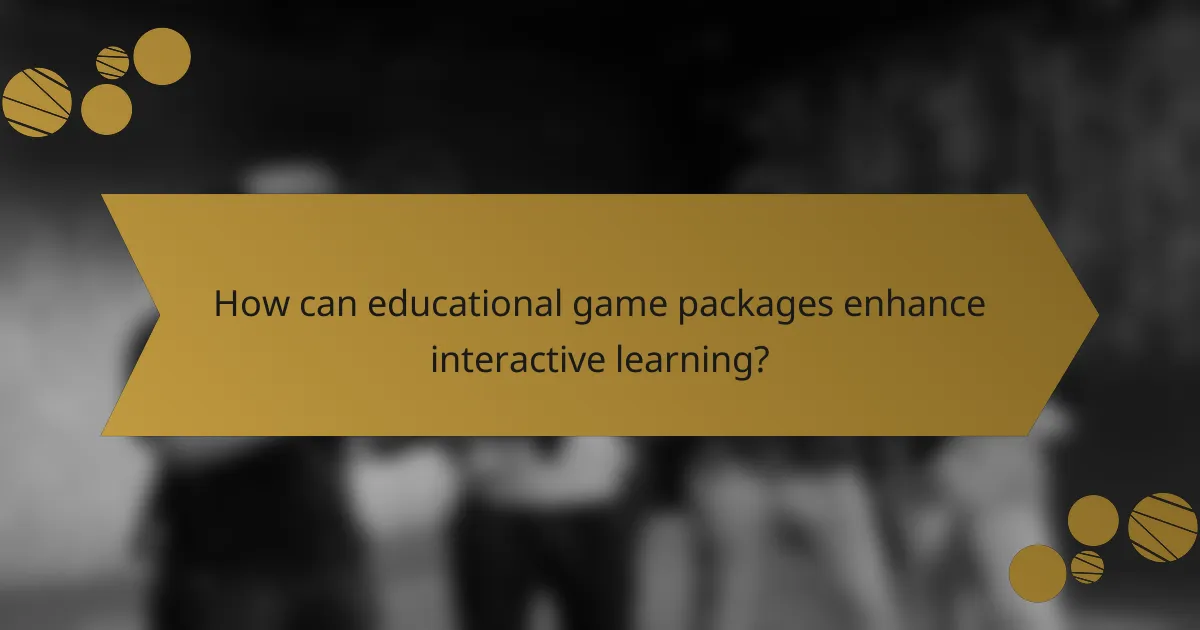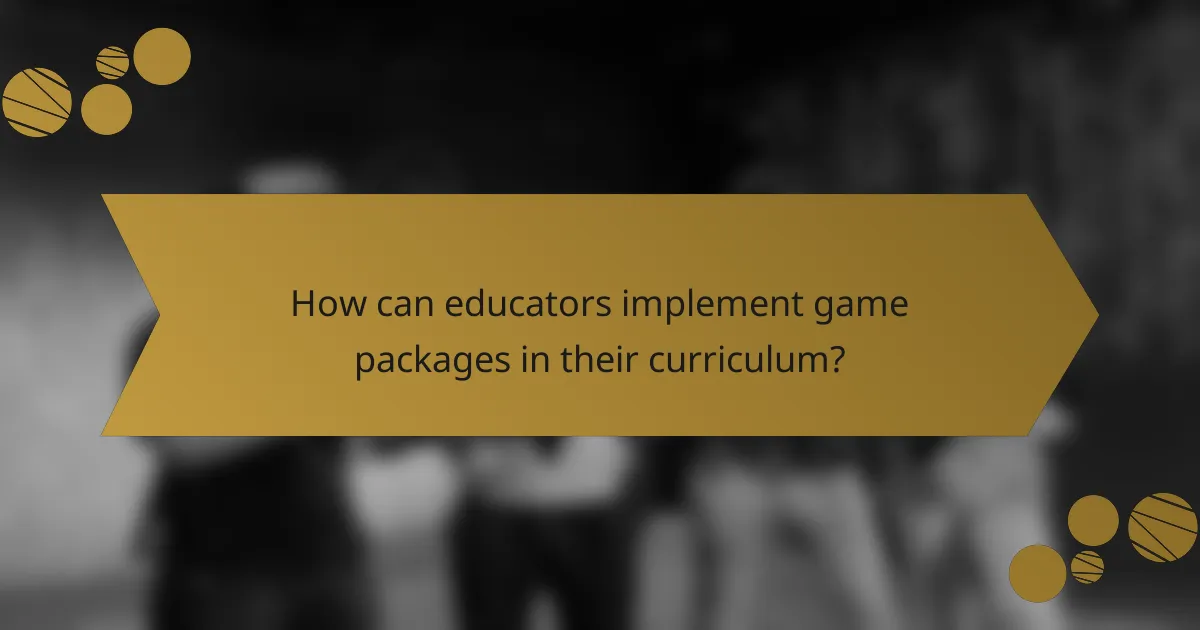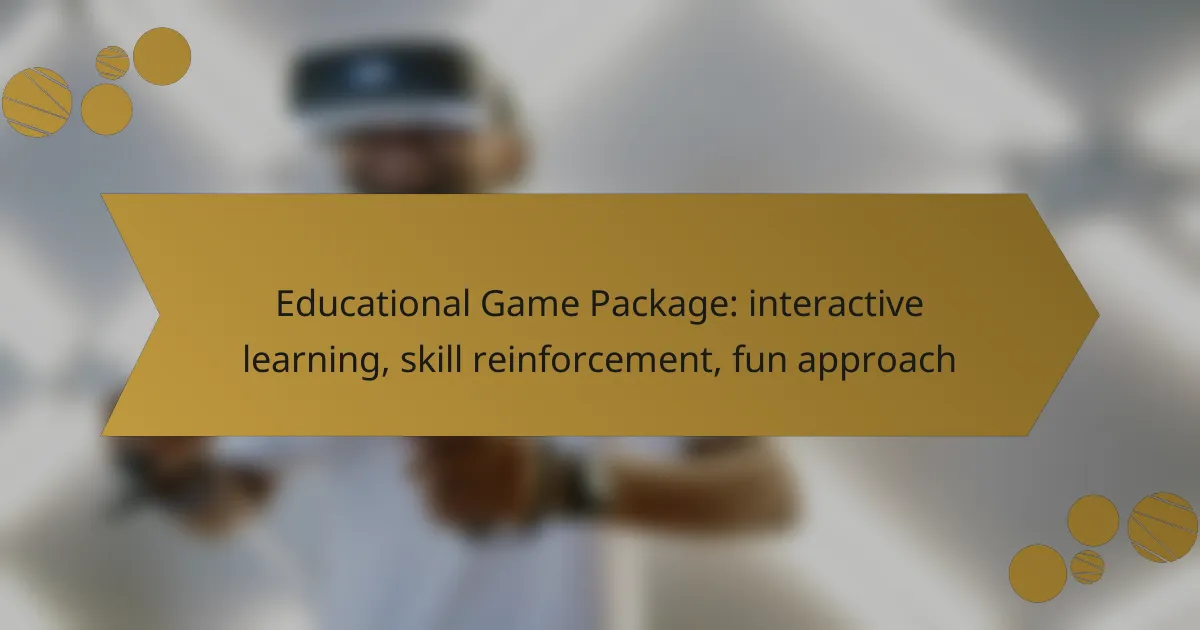Educational game packages transform the learning experience by combining interactive engagement with skill reinforcement, making education both enjoyable and effective. By catering to diverse learning styles, these games motivate students and deepen their understanding of key concepts through practical application. With a focus on fun, these tools enhance classroom dynamics and support educational objectives seamlessly.

How can educational game packages enhance interactive learning?
Educational game packages enhance interactive learning by making the process engaging and enjoyable, which helps reinforce skills effectively. These games incorporate various elements that cater to different learning styles, ensuring that students remain motivated and invested in their educational journey.
Engaging gameplay mechanics
Engaging gameplay mechanics are crucial for maintaining student interest and participation. Features such as challenges, rewards, and levels create a sense of progression that encourages learners to continue improving their skills. For instance, a math game might offer points for correct answers and unlock new levels as players advance.
Additionally, incorporating storytelling elements can make the learning experience more immersive. A game that revolves around a quest or adventure can help contextualize educational content, making it more relatable and easier to understand.
Real-time feedback for learners
Real-time feedback is a key component of educational games, allowing learners to understand their performance immediately. This instant response helps students identify areas for improvement and reinforces correct answers, enhancing retention. For example, a language learning game might provide immediate corrections on pronunciation or grammar usage.
Moreover, real-time feedback can motivate learners to try again and improve their scores. By seeing their progress in real-time, students are more likely to stay engaged and strive for better results.
Customizable learning paths
Customizable learning paths enable educators to tailor the educational experience to meet individual student needs. This flexibility allows learners to progress at their own pace, focusing on areas where they require more practice. For instance, a science game could allow students to choose specific topics or difficulty levels based on their understanding.
Additionally, customization can help accommodate different learning styles. Visual learners might benefit from games with rich graphics, while auditory learners may prefer those with engaging soundtracks and voiceovers.
Multiplayer collaboration features
Multiplayer collaboration features foster teamwork and communication among students, enhancing the overall learning experience. By working together to solve problems or complete challenges, learners can share knowledge and strategies, which reinforces their understanding of the material. For example, a history game might require players to collaborate to build a timeline of events.
These features also promote social skills and can create a sense of community in the learning environment. However, it is essential to ensure that all participants contribute equally to avoid frustration and disengagement among team members.

What are the benefits of skill reinforcement through games?
Skill reinforcement through games offers a dynamic way to enhance learning by making the process enjoyable and interactive. This approach not only helps in retaining knowledge but also fosters a deeper understanding of concepts through practical application.
Improved retention of knowledge
Games often incorporate repetition and active participation, which are key elements in reinforcing knowledge retention. When learners engage with content through gameplay, they are more likely to remember information due to the immersive experience.
For example, educational games that require players to solve problems or answer questions reinforce concepts through practice. This method can lead to better long-term memory compared to traditional rote learning techniques.
Increased motivation and engagement
Interactive games naturally boost motivation by providing immediate feedback and rewards, which keeps learners engaged. The competitive aspect of games can encourage participants to strive for improvement and mastery of skills.
Incorporating elements like points, levels, or badges can create a sense of achievement, making learners more likely to continue their educational journey. This gamified approach can be particularly effective in classrooms or online learning environments.
Development of critical thinking skills
Many educational games challenge players to think critically and make decisions based on the information presented. This process encourages learners to analyze situations, weigh options, and develop problem-solving strategies.
Games that simulate real-world scenarios, such as strategy-based or role-playing games, can enhance critical thinking by requiring players to adapt their strategies based on changing circumstances. This skill is essential not only in education but also in everyday life and future careers.

Which educational game packages are popular in the market?
Popular educational game packages engage students through interactive learning, skill reinforcement, and a fun approach. These tools enhance classroom experiences by making learning enjoyable while effectively supporting educational goals.
Kahoot! for quizzes
Kahoot! is a game-based learning platform that allows educators to create quizzes that students can answer in real-time using their devices. This interactive format fosters competition and engagement, making learning more dynamic.
To implement Kahoot!, teachers can design quizzes based on their curriculum, incorporating various question types like multiple-choice and true/false. It’s essential to ensure questions are clear and relevant to maximize student participation and learning outcomes.
Classcraft for classroom management
Classcraft transforms classroom management into a game where students earn points and rewards for positive behavior and academic achievements. This approach encourages collaboration and accountability among students, enhancing their overall learning experience.
Teachers can customize Classcraft to align with their classroom rules and objectives. It’s important to regularly update challenges and rewards to maintain student interest and motivation. Consider integrating Classcraft with existing lesson plans for a seamless experience.
Prodigy Math for math skills
Prodigy Math is an adaptive learning platform that gamifies math practice for students in grades 1-8. It personalizes learning by adjusting the difficulty of questions based on each student’s performance, ensuring they are challenged appropriately.
To use Prodigy Math effectively, educators should encourage regular practice and monitor progress through the platform’s reporting features. Setting specific goals for students can help maintain focus and improve math skills over time. Consider incorporating Prodigy into daily routines to reinforce learning consistently.

How do you choose the right educational game package?
Choosing the right educational game package involves aligning the game’s features with your learning goals, ensuring it has positive user feedback, and confirming it is suitable for the intended age group. A thoughtful selection can enhance interactive learning and skill reinforcement while keeping the experience enjoyable.
Assess learning objectives
Start by clearly defining your educational goals. Determine whether you want to reinforce specific skills, introduce new concepts, or promote critical thinking. For example, if the goal is to improve math skills, look for games that focus on problem-solving and number operations.
Next, evaluate how well the game package aligns with these objectives. Review the content and gameplay mechanics to ensure they effectively support the desired learning outcomes. Games that offer adaptive learning paths can be particularly beneficial as they adjust to the player’s skill level.
Evaluate user reviews and ratings
User reviews and ratings provide valuable insights into the game’s effectiveness and engagement level. Look for packages with high ratings and positive feedback, particularly from educators or parents who have used them in similar contexts. Pay attention to comments about the game’s educational value and user experience.
Consider using platforms that aggregate reviews, as they can offer a broader perspective. Be cautious of overly positive reviews that may not reflect genuine user experiences; look for detailed feedback that discusses both strengths and weaknesses.
Consider age-appropriateness
Age-appropriateness is crucial in selecting an educational game package. Ensure the content is suitable for the intended age group, as games designed for younger children may not challenge older students adequately. Check the recommended age range provided by the publisher.
Additionally, consider cognitive and emotional maturity when assessing appropriateness. A game that is too complex or too simplistic can lead to frustration or boredom, undermining the learning experience. Look for games that offer varying difficulty levels to cater to a range of abilities within the same age group.

What features should you look for in an educational game package?
When selecting an educational game package, prioritize features that enhance interactive learning, reinforce skills, and provide a fun experience. Key aspects include adaptive learning technology, cross-platform compatibility, and robust analytics and reporting tools.
Adaptive learning technology
Adaptive learning technology personalizes the educational experience by adjusting the difficulty and type of content based on the learner’s performance. This ensures that students are challenged appropriately, which can enhance engagement and retention of skills.
Look for packages that utilize algorithms to assess progress and modify learning paths in real-time. For example, if a student struggles with a specific math concept, the game can offer additional practice or alternative explanations to reinforce understanding.
Cross-platform compatibility
Cross-platform compatibility allows users to access educational games on various devices, such as tablets, smartphones, and computers. This flexibility ensures that learners can engage with the material anytime and anywhere, which is essential for maintaining motivation.
When evaluating options, check if the game package supports both iOS and Android systems, as well as web browsers. A seamless experience across platforms can significantly enhance user satisfaction and learning outcomes.
Analytics and reporting tools
Analytics and reporting tools provide valuable insights into a learner’s progress and performance. These features enable educators and parents to track skill development, identify areas needing improvement, and tailor future learning experiences accordingly.
Choose educational game packages that offer detailed reports on metrics such as time spent on tasks, accuracy rates, and overall progress. This data can inform instructional strategies and help in setting achievable goals for learners.

How can educators implement game packages in their curriculum?
Educators can effectively implement game packages in their curriculum by integrating interactive learning experiences that reinforce skills while making the process enjoyable. This approach not only enhances student engagement but also promotes deeper understanding of the material.
Integrate games into lesson plans
To integrate games into lesson plans, educators should select games that align with learning objectives and subject matter. For instance, using math-based games can help students practice arithmetic skills while reinforcing concepts taught in class.
Consider incorporating a variety of game types, such as board games, digital games, or role-playing activities, to cater to different learning styles. A balanced mix can keep students motivated and engaged throughout the learning process.
Use games for formative assessments
Games can serve as effective tools for formative assessments by providing real-time feedback on student understanding. For example, educators can use quiz-based games to gauge knowledge retention and identify areas needing improvement.
When using games for assessments, ensure that they are designed to highlight specific learning outcomes. This allows educators to track progress and adapt instruction based on student performance. Avoid overly complex games that may distract from the assessment goals.

